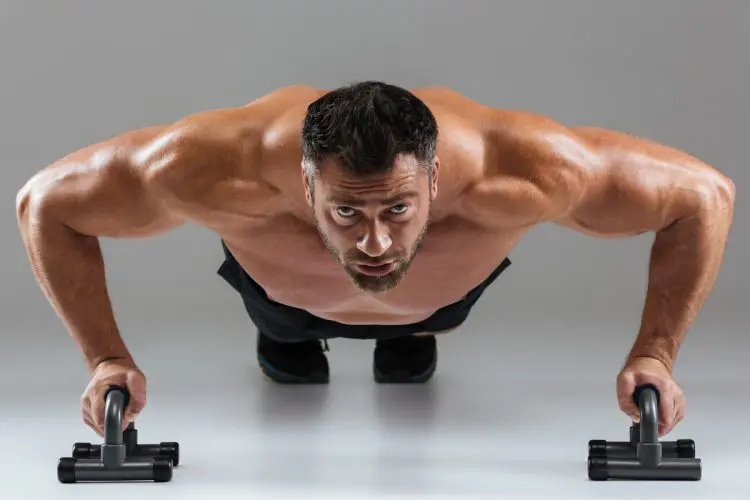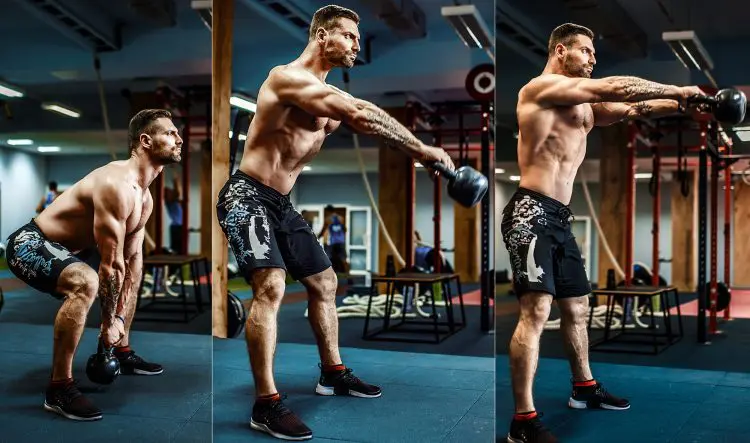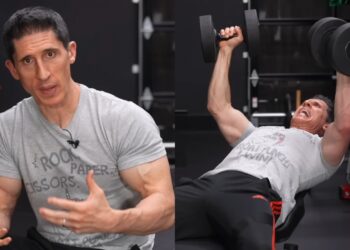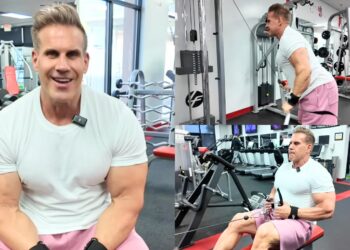Train at a gym long enough, and a friendly neighborhood gym bro, with disappointment in his eyes, will at some point ask you to work on your muscular endurance. With dumbbells still in your hands, you might wonder if lifting weight doesn’t improve muscle endurance. The answer – yes and no. Before we jump into the nitty-gritty, let’s take a step back.
What is Muscular Endurance?
Muscular endurance is the ability to exert force consistently and repetitively over an extended period. To put it simply, it refers to how long your muscles can sustain an exercise. If you do anything remotely physically challenging, muscular endurance will play a vital role in your performance.
But isn’t that stamina? We are glad you asked.
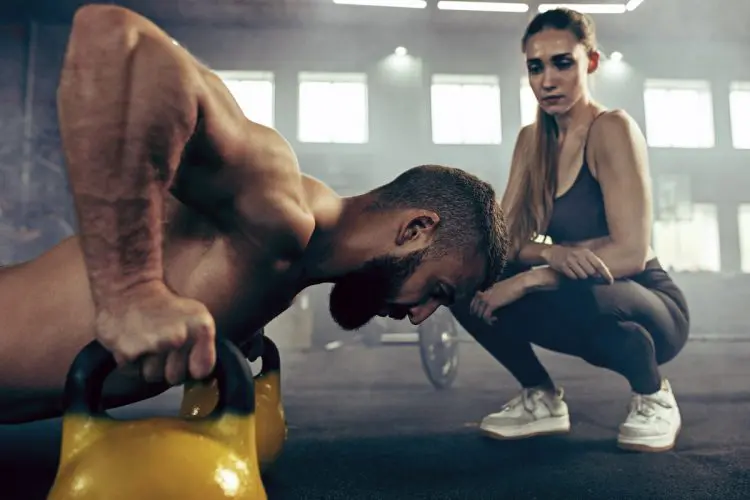
Muscular Endurance vs. Stamina
Many people use the terms “stamina” and “endurance” interchangeably. However, there are a few subtle differences between them, and knowing the distinctions can help you work on them effectively. At the very least, you’ll have some knowledge bombs to drop the next time someone lectures you about muscular endurance.
Stamina
Stamina is usually referred to as the ability to perform an activity without getting tired. You could think of stamina as the opposite of fatigue or the ability to feel energetic for a prolonged period. Stamina is measured subjectively and can mean different things to different people.
Level Up Your Fitness: Join our 💪 strong community in Fitness Volt Newsletter. Get daily inspiration, expert-backed workouts, nutrition tips, the latest in strength sports, and the support you need to reach your goals. Subscribe for free!
Stamina for a football player might mean being able to get through a game without a performance dip. And on the other hand, an 80-year old granddad who can keep up with his grandchildren can be said to have decent stamina.
Endurance
Endurance is the ability to sustain an exercise with a peak performance level over an extended period. It consists of two components:
- Cardiovascular Endurance – The ability of your heart and lungs to power your body using oxygen. It is also known as aerobic endurance.
- Muscular Endurance – The ability of your muscles to work continuously without compromising on performance and getting tired while the heart isn’t able to supply enough oxygen to the muscles due to rigorous physical exertion. Muscular endurance, aka, anaerobic endurance is our main focus for now, and you’ll be a pro at it by the time you’re done reading this article.
The Major Differentiator Between Endurance & Stamina
While endurance is a component of physical fitness, stamina isn’t. According to studies, the five components of physical fitness include:
- Muscular Endurance
- Cardiovascular Endurance
- Flexibility
- Body Composition
- Muscular Strength
Stamina is the result of getting fitter. Improving your physical fitness level (muscular endurance with the other five components) can lead to enhanced stamina.
While stamina is measured subjectively, muscular endurance can be gauged objectively against benchmarks. For example, upper body strength could be measured using a push-up test and the results can be compared to benchmarks for certain age/weight groups.
Putting It Together
Let’s say John is a 50-year-old sedentary man who is always tired and lethargic but wants to work on his fitness. He starts a 12-week walking program following the advice of a fitness coach. At the end of the training period, John will:
- Have more energy throughout the day to do everyday chores. He should notice that he doesn’t fatigue as often. This is a sign of improved stamina.
- Be able to cover a greater distance at a faster pace as compared to what he did when he started the program. A cue for enhanced endurance.
Benefits of Muscular Endurance
Now, you might be saying to yourself, “I don’t want to do a 12-week walking program, or perform physically challenging tasks, so why should I improve my muscular endurance?” As mentioned earlier, muscular endurance is one of the five pillars of physical fitness.
We hope we don’t need to tell you what happens to a building when even one of its pillars faulters. To perform at optimal levels, you need to train with a holistic approach which happens to be a weak spot for most lifters.
Most lifters focus mainly on strength and hypertrophy, and so their muscular endurance suffers. While weight training can help improve endurance, you won’t see meaningful results if you’re not designing your workouts to actively work on it.
A robust muscular endurance training program is beneficial because it:
- Improves Daily Functioning – Enhanced endurance leads to better stamina which then results in better body functionality.
- Better Sex – Your welcome!
- Reduces Risk of Injury – If your muscle endurance is lagging, your overall physical fitness will take a hit and put you at a greater risk of an injury. Waning muscle endurance will result in more pressure being exerted on your muscles during physical activities that can cause the muscles to weaken over time.
- Maintains Bodyweight – Guess what happens if you have better muscular endurance and stamina. You’ll do more work, and for longer. And guess what would that lead to. Fat loss because of improved metabolic rates.
- Improves Balance – Poor muscular endurance will lead to deteriorating muscle composition. Bad muscle composition and symmetry can also cause poor body balance. People with poor endurance usually experience a greater level of structural imbalance as they get fatigued.
- Stronger Muscles, Joints & Bones – Superior endurance can help in strengthening your muscles and improving bone density. A melioration in endurance will also assist in developing a good posture.
- Higher Energy Levels – Most people desire a stamina boost so they can remain energetic throughout the day.
- Boosts Sleep Quality – A high endurance level will keep you functioning at a peak degree throughout the day. Working at elevated intensity will eventually deplete your energy reserves which will help you fall asleep faster. Studies have shown that improved muscular endurance can result in better sleep quality. To sum it up, you’re getting improved physical performance, better sex, and deep sleep just by increasing your muscular endurance. Do you still have an excuse not to work on your endurance and stamina?
Read Also: Quick Tips To Improve Your Metabolism
Types of Muscular Endurance
There are three kinds of endurance that anyone who is looking to improve his performance should focus on:
- Power Endurance – It is the most badass type of muscular endurance as it involves the ability to perform explosive moves repeatedly over longer periods with little to no rest in between. Eg – boxing, football, basketball, tennis, wrestlers.
- Short-Term Endurance – It’s the ability to exert maximum effort for a short period. Eg – a 60-second sprint, footballer playing in an offensive position, basketball.
- Long-Term Endurance – As you might have guessed by now, long-term endurance requires you to remain active with peak performance over longer durations. Think rowers, marathon runners, basketballers, boxers.
We know what you’re thinking. Why are some of the activities present in all three types of endurance? It’s because longer-duration activities need you to perform at different endurance levels.
Muscular Endurance Test
Level Up Your Fitness: Join our 💪 strong community in Fitness Volt Newsletter. Get daily inspiration, expert-backed workouts, nutrition tips, the latest in strength sports, and the support you need to reach your goals. Subscribe for free!
Enough with the babbling. Let’s get down and dirty. Before you get too excited, we’re talking about fitness tests here.
The majority of the time, especially if you don’t work out, your body is the resistance itself. The measurement of muscular endurance will depend on the number of repetitions performed of an exercise or the duration for which a position is held in case of isometric training.
Some Of The Best Exercises For Testing Muscular Endurance:
Push-Ups
Push-ups are meant to test your upper body endurance. Perform as many repetitions as you can with a strict form. If you’re serious about your progress, note down the time duration along with the reps you completed.
Static / Wall Squat Test
The lower body endurance can be evaluated by performing wall squats. Place your back against a wall and stand with a shoulder-wide stance. Get into a squatting position until your upper legs are parallel to the floor. Hold this position for as long as you can.
Sit-Up Test
Perform the sit-ups to failure and record the number of repetitions and time.
The core is arguably one of the most overlooked aspects when it comes to endurance training. A strong core is what gives you stability and balance. You’ll be performing six different core endurance tests as per this guide.
Plank Hold
Planks are one of the most popular core exercises around the globe. They are an incredibly effective way of testing your core endurance. Hold a plank in a strict position for as long as you can.
McGill Core Endurance Test
The McGill endurance test is a vigorous method of accessing your core endurance. It consists of four exercises that measure all aspects of torso strength via isometric muscle endurance.
- Trunk Flexor Test (TFT)
- Trunk Extensor Test (TET)
- Lateral Musculature Test & Right Lateral Musculature Test
Results
The optimal rep range for muscular endurance is:
- Bodyweight Exercises: 20+ reps,
- Free Weight Exercises: 15+ reps (using about 50-60% of your 1RM),
- Isometric Exercises: 1-Minute Hold.
Once you reach these rep ranges, your goal should be to do more and not let your body hit a plateau. Your muscles should be filled with lactic acid and asking for mercy by the end of your workouts.
Exercises For Improving Muscular Endurance

Best Bodyweight Muscular Endurance Exercises:
- Squats
- Push-Ups
- Crunches
- Handstands
- Inverted Rows
- Pull-Ups
- Lunges
- Pike Crunches
- Dips
- Planks
Read also: Hardcore Bodyweight Exercises For More Muscle and Strength
Best Free Weight / Resistance Muscular Endurance Exercises:
- Squats
- Farmer’s Walk
- Kettlebell Swings
- Deadlifts
- Kettlebell Crush Curl
- Bench Press
- Military Press
- Rows
- Sandbag Exercises
- Rucking
Muscular Endurance Training Program To Take Your Gains To The Next Level
Contrary to what many trainers would have you believe, you don’t need stand-alone training programs to improve your muscular endurance. Performing a few “finisher” sets at the end of your normal workout routine is enough to get you closer to your endurance and stamina goal.
You could complement these finisher sets with a once-a-week training session dedicated solely to muscular endurance. For the best results, you should be doing some aerobic endurance workouts along with anaerobic endurance lifts. A low-intensity running session after a workout is great for building endurance and stamina.
Muscular Endurance Finisher #1
- Push-ups – 3 Sets to Failure
- Kettlebell Swings – 4 Sets 20-30 Reps
- Sandbag Exercises – 3 Sets 2 Minutes Each
Muscular Endurance Finisher #2
- Pull-Ups (3-second static hold at the top) – 3 Sets to Failure
- Barbell Romanian Deadlifts – 3 Sets 15-20 Reps
- Farmer’s Walk – 5 Sets to Failure
Muscular Endurance Finisher #3
- Crunches – 3 Sets to Failure
- Squats – 4 Sets 20 Reps
- Inverted Rows – 5 Sets to Failure
Similarly, you can create your own variations of the finishers using the exercises listed above. Your goal should be to shock and annihilate your muscles with every workout. You’ll never be able to improve your endurance and stamina if you arek not able to break a plateau.
Full Muscular Endurance Training Session (Once-a-Week)
Pull-up and Push-up Density Block – 30 minutes
Start by performing 15 minutes of pull-ups and then switch to the push-ups. In these 15 minutes, perform as many sets as you can to failure. Keep your rest duration to the bare minimum. Try to beat the number of sets and reps you did the previous week (increase the allotted time if you have to).
Muscular Endurance Circuit – 2 Sets 25-50 Reps
- Rows
- Kettlebell Swings
- Bodyweight Inverted Rows
- Push-up-Position Planks – 2 Sets 1 Minute Hold
Conclusion
Training for optimal muscular endurance should be backed with a protein-rich diet and a sound recovery program. You should never attempt to improve your aerobic and anaerobic endurance while you’re running a calorie deficit. Doing that would beat the entire purpose of the program as you’d be running on fumes and dragging your feet throughout the day.
Muscular endurance is one of the pillars and a valuable aspect of overall fitness but you shouldn’t make it your primary focus unless you are prepping to break PRs.


